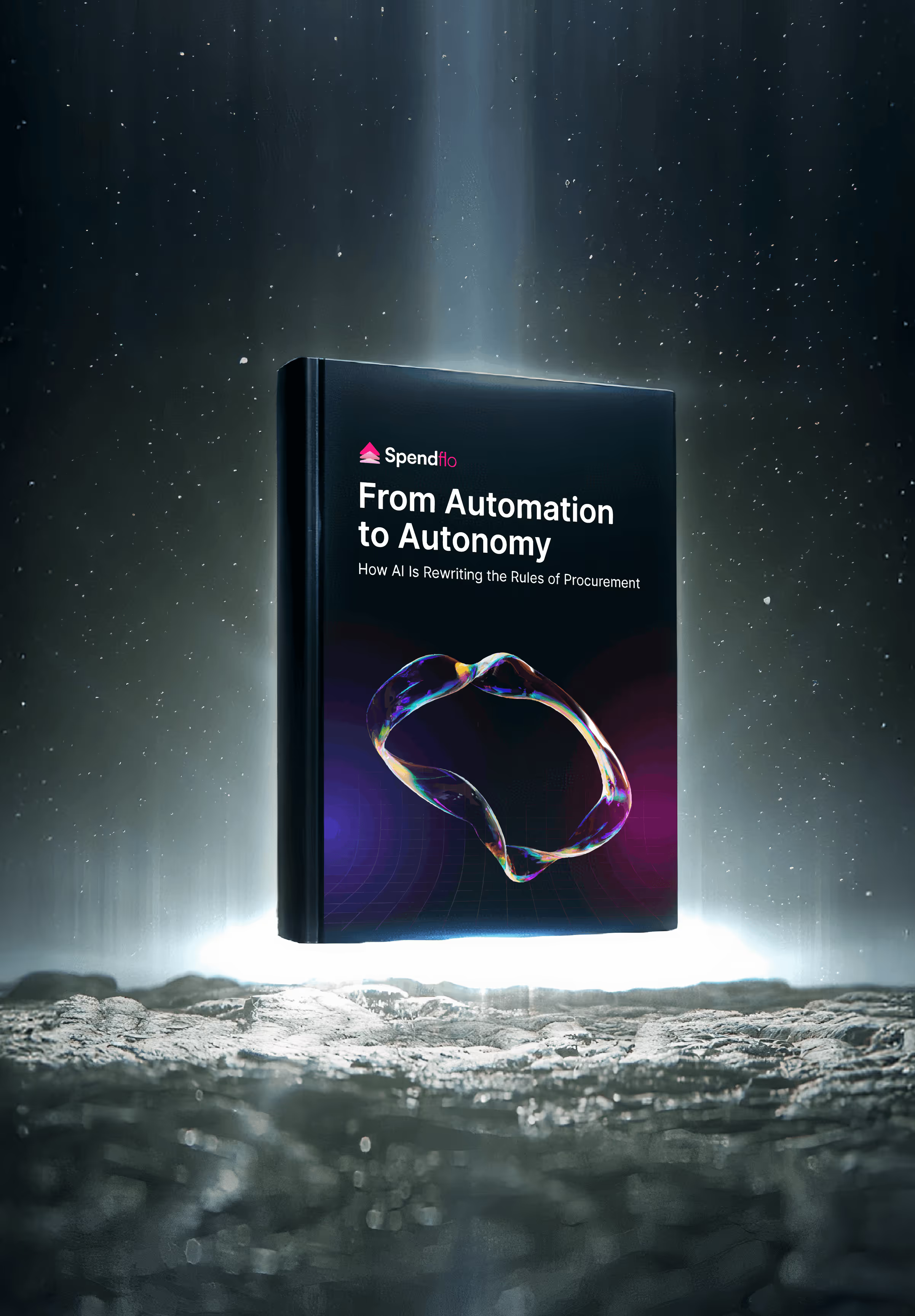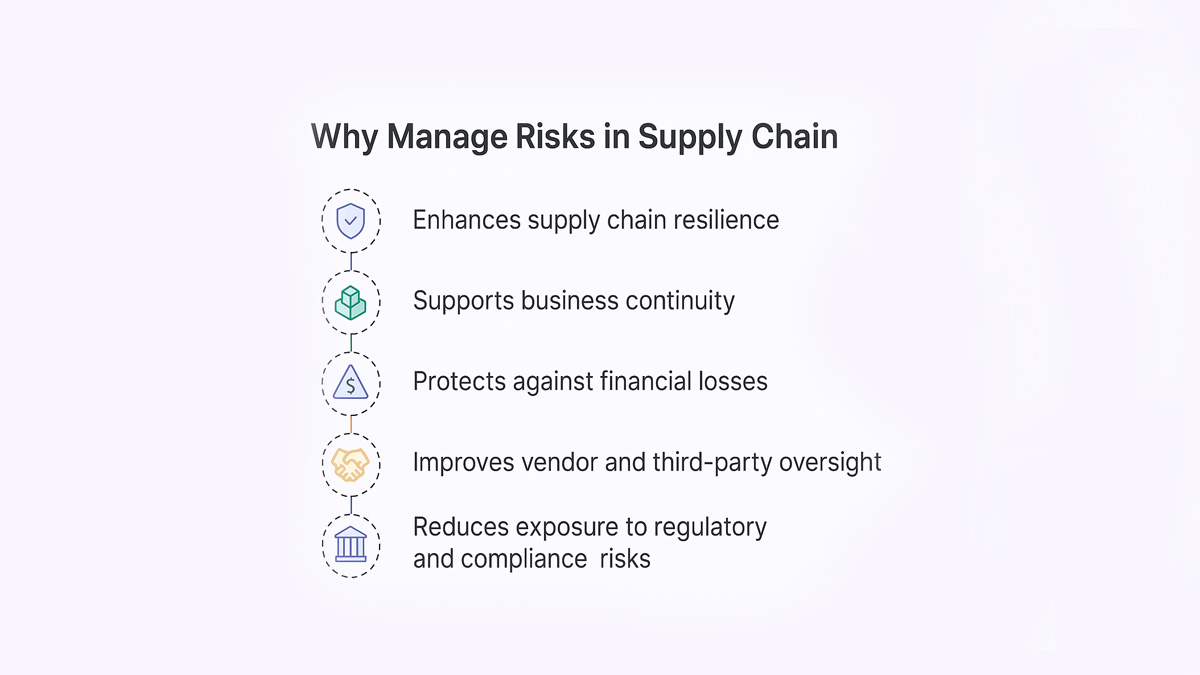

What Is Supply Chain Risk Management? A Practical Guide

What Is Supply Chain Risk Management? A Practical Guide
Learn what supply chain risk management is, why it’s important, and how to protect operations through proactive risk assessment and mitigation.


Supply chain risk management (SCRM) is an essential capability for companies operating in today’s complex and interconnected markets. Supply chains now span multiple countries, time zones, and compliance environments, making them efficient but also vulnerable. A single disruption - such as a cyberattack, port closure, extreme weather event, or political dispute - can cause widespread delays, financial losses, and damage to customer trust.
The last few years have shown how fragile global supply chains can be when exposed to large-scale supply chain disruptions and underlying supply chain vulnerabilities. The COVID-19 pandemic halted manufacturing and logistics worldwide, the semiconductor shortage stalled entire industries, and shipping container bottlenecks pushed transportation costs to record highs. Companies with effective SCRM frameworks adapted faster, reduced damage, and in some cases gained market share. For modern businesses, managing supply chain risks is not optional - it’s a competitive necessity.
What this blog covers:
- What is supply chain risk management
- Why is supply chain risk management important
- Supply chain risks and challenges
- What are best practices for managing supply chain risk
- How Spendflo helps with supply chain risk management
- Frequently asked questions on supply chain risk management
What is Supply Chain Risk Management?
Supply chain risk management is the process of identifying, assessing, and mitigating potential threats that could disrupt the movement of goods, services, or information. It ensures operational stability by addressing vulnerabilities early, preventing costly financial, operational, and reputational damage.
Why is Supply Chain Risk Management Important?
Effective supply chain risk management enables businesses to operate confidently in uncertain environments. By anticipating potential disruptions and preparing strategies to address them, companies can protect revenue, maintain service quality, and safeguard brand reputation. It is not just a defensive measure - it can also create a competitive advantage, enabling companies to respond faster than rivals when unexpected events occur.

Enhances Supply Chain Resilience
Resilience is the ability to adapt quickly when disruptions occur. Businesses with diversified suppliers, alternative logistics routes, and flexible production schedules can recover faster from unforeseen events. For example, during the 2021 shipping container shortage, companies with multiple transport options managed to keep deliveries on schedule. This adaptability minimizes downtime, ensures customer commitments are met, and prevents long-term operational setbacks. A robust risk management framework that includes precise risk measurement helps organizations prioritize and address threats efficiently. Successful risk mitigation relies on well-designed mitigation strategies that address both immediate threats and long-term weaknesses.
Supports Business Continuity
Business continuity planning ensures operations continue even during crises. Measures such as maintaining safety stock, implementing redundant manufacturing capabilities, and securing alternative transport arrangements help sustain production and delivery. When a natural disaster impacts one facility, a well-prepared company can shift production to another location without significant delays, protecting customer relationships.
Protects Against Financial Losses
Disruptions can create sudden expenses - expedited shipping fees, overtime labor costs, or penalties for missed deadlines. By proactively identifying risks and developing contingency plans, companies avoid reactive spending. For example, a manufacturer with pre-negotiated emergency supply agreements can avoid paying inflated spot prices during shortages.
Improves Vendor and Third-Party Oversight
Vendors and third parties are integral to supply chain performance. Regular performance evaluations, compliance checks, and relationship management allow companies to identify supplier risk early - whether from direct suppliers or third-party vendors - before they cause broader operational issues. In regulated industries, this oversight is critical to avoiding costly recalls or sanctions.
Reduces Exposure to Regulatory and Compliance Risks
Changes in trade laws, labor standards, and environmental regulations can impact supply chain operations. Embedding compliance monitoring into procurement processes ensures adherence to these requirements, avoiding fines, legal disputes, and reputational harm. For example, companies importing goods from multiple countries can track compliance across jurisdictions to prevent customs delays.
Supply Chain Risks and Challenges
Supply chains face diverse risks, many of which are interconnected and capable of causing ripple effects across industries. Understanding these threats is the foundation for building effective risk management strategies. Incorporating these insights into broader supply chain management strengthens the resilience of the entire supply network.
Cybersecurity Threats and Technology Dependencies
As supply chains rely more heavily on digital tools for inventory tracking, order processing, and supplier communication, the threat of cyberattacks grows. A ransomware attack on a logistics provider can paralyze operations, delaying shipments for weeks. Similarly, system outages caused by software glitches or cyber intrusions can disrupt real-time data sharing, leaving teams without the information needed to make timely decisions. Protecting these systems with robust cybersecurity measures, advanced supply chain security protocols, and preparation for a potential supply chain attack is essential.
Geopolitical Disruptions and National Security Concerns
Political instability, trade disputes, and sudden regulatory changes can drastically alter supply chain dynamics. For example, sanctions on certain countries can block access to critical raw materials, forcing businesses to find alternative sources on short notice. National security concerns can also lead to stricter import/export controls, requiring companies to adapt their procurement and logistics strategies rapidly to remain compliant and operational.
Just-in-Time (JIT) Models and Inventory Buffers
The JIT model minimizes inventory costs by receiving goods only as they are needed, but it leaves little room for error. A port delay, transport strike, or supplier issue can halt production entirely. Without adequate inventory buffers, companies may be forced into costly emergency procurement, sometimes at inflated prices. Striking the right balance between efficiency and resilience is key to mitigating this risk.
Environmental and Climate-Related Events
Extreme weather events such as floods, hurricanes, and wildfires can damage production facilities, block transport routes, and disrupt supplier operations. Climate change is increasing both the frequency and severity of such events, making them a growing concern for global supply chains. Factoring in environmental risk and planning for potential risk events ensures companies can adapt to both seasonal and unexpected disruptions. Companies that factor climate resilience into their sourcing and logistics planning are better positioned to recover quickly after such disruptions.
Best Practices for Managing Supply Chain Risk
Implementing best practices in supply chain risk management ensures organizations can respond effectively to disruptions and minimize their impact. These strategies focus on prevention, preparedness, and agility in the face of uncertainty.

Conduct Regular Risk Assessments and Due Diligence
Frequent evaluations of suppliers, logistics partners, and internal processes help identify vulnerabilities before they escalate. Site visits, supplier audits, and financial health checks can reveal potential weaknesses in a partner’s operations. For instance, reviewing a supplier’s contingency plans can confirm whether they can continue delivering during unexpected events.
Build Strong Supplier Relationships and Communication
Collaborative, transparent relationships with suppliers foster trust and enable proactive problem-solving. Open channels of communication mean suppliers are more likely to share early warnings about production issues, labor disputes, or raw material shortages. This early notice allows businesses to prepare alternative solutions and avoid last-minute crises.
Diversify Vendors and Reduce Third-Party Dependencies
Relying heavily on one supplier or region can create significant vulnerability. Diversifying sourcing across multiple suppliers and geographic areas spreads risk and improves resilience. This approach minimizes the operational impact of unexpected supply disruptions, helping maintain consistent output. For example, a company that sources components from both Asia and Europe can continue operations if political tensions or transport strikes affect one region.
Adopt Digital Tools for Risk Monitoring and Response
Technology plays a crucial role in modern procurement risk management. Predictive analytics can flag potential disruptions before they occur, while AI-powered alerts can provide real-time updates on shipment delays or supplier performance issues. Leveraging artificial intelligence alongside advanced risk assessment tools enables faster and more accurate decision-making in complex scenarios. Blockchain-based systems offer end-to-end visibility, enhancing traceability and trust across the supply chain.
By combining these best practices, businesses create a layered defense against disruptions. The result is a supply chain that is not only more secure but also more adaptable to the evolving risks of a global marketplace.
How Spendflo Helps with Supply Chain Risk Management
Spendflo enables organizations to integrate robust risk management practices directly into their procurement and vendor oversight processes. The platform consolidates supplier contracts, compliance records, and performance data into a single, accessible dashboard. This centralization provides procurement teams with real-time visibility into vendor health, regulatory adherence, and operational performance.
Automated monitoring tools flag potential issues early, such as declining delivery reliability or missed compliance milestones. These insights empower teams to take swift action - whether renegotiating terms, securing alternative suppliers, or adjusting production schedules. By equipping businesses with data-driven decision-making capabilities, Spendflo helps maintain continuity, avoid costly disruptions, and strengthen supplier relationships.
To strengthen your risk mitigation strategy, here’s a complete guide to the best Supplier Risk Management Software for identifying high-risk suppliers early.
Frequently Asked Questions on Supply Chain Risk Management
What are the key benefits of supply chain risk management?
Supply chain risk management strengthens resilience, ensures operational continuity, and protects profitability. It also enhances vendor oversight, supports compliance, and helps organizations respond more effectively to disruptions, giving them a competitive edge in challenging market conditions.
How does digital technology help in managing supply chain risks?
Digital tools provide real-time tracking, predictive analytics, and automated alerts that enable faster responses to potential threats. By using technologies such as AI and blockchain, companies gain greater visibility into their operations and can detect problems before they escalate.
What role does vendor diversification play in risk reduction?
Vendor diversification reduces dependency on a single supplier or region, which limits the impact of localized disruptions. A diverse supplier network also allows businesses to adapt more quickly if one source becomes unavailable, ensuring continuity of operations.
What are the biggest challenges in implementing a risk strategy?
Challenges include limited visibility into supplier operations, resource constraints, and rapidly changing global risk factors. Overcoming these issues requires investment in monitoring tools, strong supplier partnerships, and a culture of proactive risk awareness across the organization.
How often should risk assessments be conducted?
At a minimum, companies should conduct risk assessments annually. Additional reviews are recommended after significant operational changes, market disruptions, or the introduction of new suppliers. Regular assessments keep risk strategies relevant and responsive to evolving threats.










.png)




.png)










.avif)





